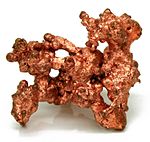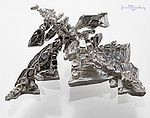- Group 11 element
-
Group → 11 ↓ Period 4 
29
Cu5 
47
Ag6 
79
Au7 111
Rg
Legend Transition metal Primordial element Synthetic A Group 11 element is one in the series of elements in group 11 (IUPAC style) in the periodic table, consisting of transition metals which are the traditional coinage metals of copper (Cu), silver (Ag), and gold (Au). Roentgenium (Rg) belongs to this group of elements based on its electronic configuration, but it is a short-lived transactinide with a 22.8 seconds half-life that has only been observed in laboratory conditions. Although at various times societies have used other metals in coinage including aluminium, lead, nickel, stainless steel, tin, and zinc, the name "coinage metals" is used to highlight the special physio-chemical properties that make this series of metals uniquely well suited for monetary purposes. These properties include ease of identification, resistance to tarnish, extreme difficulty in counterfeiting, durability, fungibility and a reliable store of value unmatched by any other metals known.
Contents
History
All the elements of the group except Roentgenium have been known since prehistoric times, as all of them occur in metallic form in nature and no extraction metallurgy has to be used to produce them.
Characteristics
Like other groups, the members of this family show patterns in its electron configuration, especially the outermost shells resulting in trends in chemical behavior (although roentgenium is probably an exception):
Z Element No. of electrons/shell 29 copper 2, 8, 18, 1 47 silver 2, 8, 18, 18, 1 79 gold 2, 8, 18, 32, 18, 1 111 roentgenium 2, 8, 18, 32, 32, 17, 2 They are all relatively inert, corrosion-resistant metals. Copper and gold are colored.
These elements have low electrical resistivity so they are used for wiring. Copper is the cheapest and most widely used. Bond wires for integrated circuits are usually gold. Silver and silver plated copper wiring are found in some special applications.
Applications
These metals, especially silver, have unusual properties that make them essential for industrial applications outside of their monetary or decorative value. They are all excellent conductors of electricity. The most conductive of all metals are silver, copper and gold in that order. Silver is also the most thermally conductive element, and the most light reflecting element. Silver also has the unusual property that the tarnish that forms on silver is still highly electrically conductive.
Copper is used extensively in electrical wiring and circuitry. Gold contacts are sometimes found in precision equipment for their ability to remain corrosion-free. Silver is used widely in mission-critical applications as electrical contacts, and is also used in photography (because silver nitrate reverts to metal on exposure to light), agriculture, medicine, audiophile and scientific applications.
Gold, silver, and copper are quite soft metals and so are easily damaged in daily use as coins. Precious metal may also be easily abraded and worn away through use. In their numismatic functions these metals must be alloyed with other metals to afford coins greater durability. The alloying with other metals makes the resulting coins harder, less likely to become deformed and more resistant to wear.
Gold coins: Gold coins are typically produced as either 90% gold (e.g. with pre-1933 US coins), or 22 carat (92%) gold (e.g. current collectible coins and Krugerrands), with copper and silver making up the remaining weight in each case. Bullion gold coins are being produced with up to 99.999% gold (in the Canadian Gold Maple Leaf series).
Silver coins: Silver coins are typically produced as either 90% silver - in the case of pre 1965 US minted coins (which were circulated in many countries), or sterling silver (92.5%) coins for pre-1920 British Commonwealth and other silver coinage, with copper making up the remaining weight in each case.
Copper coins: Copper coins are often of quite high purity, around 97%, and are usually alloyed with small amounts of zinc and tin.
Inflation has caused the face value of coins to fall below the hard currency value of the historically used metals. This had led to most modern coins being made of base metals - copper nickel (around 80:20, silver in color) is popular as are nickel-brass (copper (75), nickel (5) and zinc (20), gold in color), manganese-brass (copper, zinc, manganese, and nickel), bronze, or simple plated steel.
See also
Explanation of right side periodic table slice: Transition metals atomic numbers in black are solids solid borders are older than the Earth (Primordial elements) dashed borders have no isotopes older than the earth References
Periodic tables Layouts Standard · Large table · Inline f-block · Vertical · Text only · Metals and nonmetals · Blocks · Valences · Extension beyond the 7th period · Large extended table · Electron configurations · Electronegativities · Alternatives · Crystal structure · Discovery periodsList of elements by Name etymology (symbol) · Discovery · Oxidation state · Abundance (in humans) · Nuclear stability · Hardness · Atomic properties · ProductionGroups 1 (Alkali metals) · 2 (Alkaline earth metals) · 3 · 4 · 5 · 6 · 7 · 8 · 9 · 10 · 11 · 12 · 13 (Boron group) · 14 (Carbon group) · 15 (Pnictogens) · 16 (Chalcogens) · 17 (Halogens) · 18 (Noble gases)Other element categories Periods · Metals · Transition metals · Metalloids · Nonmetals · Lanthanides · Actinides · Rare earth elements · Platinum group metals (PGMs) · Post-transition metals · Refractory metalsBlocks Periods  Book:Periodic table ·
Book:Periodic table ·  Category:Periodic table ·
Category:Periodic table ·  Portal:Chemistry
Portal:ChemistryGroup 11 elements Copper
Cu
Atomic Number: 29
Atomic Weight: 63.546
Melting Point: 1357.75 K
Boiling Point: 2835 K
Specific mass: 8.96 g/cm3
Electronegativity: 1.9Silver
Ag
Atomic Number: 47
Atomic Weight: 107.8682
Melting Point: 1234.15 K
Boiling Point: 2435 K
Specific mass: 10.501 g/cm3
Electronegativity: 2.2Gold
Au
Atomic Number: 79
Atomic Weight: 196.966569
Melting Point: 1337.73 K
Boiling Point: 3129 K
Specific mass: 19.282 g/cm3
Electronegativity: 2.54Roentgenium
Rg
Atomic Number: 111
Atomic Weight: 272
Melting Point: ? K
Boiling Point: ? K
Specific mass: ? g/cm3
Electronegativity: ?Categories:- Periodic table
- Chemical element groups
- Currency production
Wikimedia Foundation. 2010.
